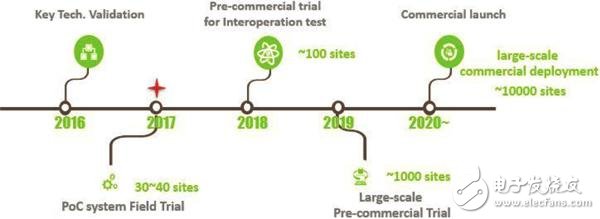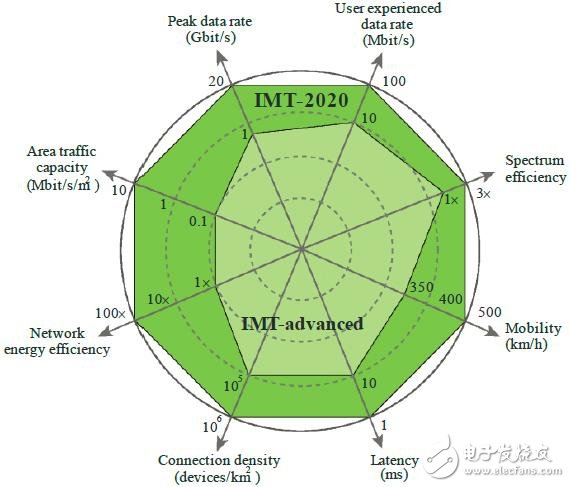1 Introduction 2. Key performance 3. New air port characteristics 3.1 General Information (General Scheme) 3.1.1 Parameter set and frame structure 3.2 Basic transmission scheme 3.2.1 Modulation 3.2.2 Channel coding 3.2.3 Multi-antenna technology 3.3 Physical layer process 3.3.1 Scheduling 3.3.2 HARQ 3.3.3 Initial access and mobility 3.3.4 Power Control 3.4 Other technologies 3.4.1 HPUE (High Power Terminal) 4. 5G PoC verification 4.1 PoC System Configuration 4.2 Verification test items After the large-scale commercialization of 4G, the fifth-generation mobile communication (5G) has also attracted global attention. 5G is expected to be commercially available around 2020. It can meet the needs of the user's ultimate experience and stimulate innovative services, so it will undoubtedly become one of the important engines of human social economic development and social information. With the joint efforts of the global mobile industry, through years of joint research by various advancing groups and forums around the world, the 5G vision and key requirements have been unified in the ITU-R. These promotion groups include IMT-2020 Promotion Group, 5GIA, 5G Forum, 5GMF, 5G Americas, 5GPPP, NGMN and so on. The three most representative deployment scenarios have also been identified, namely enhanced mobile broadband (eMBB), low latency high reliability (URLLC) and low power large connections (mMTC). Views on performance metrics have also been agreed, such as peak rate, control plane and user plane delay, reliability, and other key metrics defined in ITU-R M.2083. Based on the content defined in ITU-R, the world's most influential cellular communication standards development organization, 3GPP, began work on 5G standardization in 2016. A series of 5G research projects, such as new business enablement, new architecture and new air interface, were completed in early 2017. The goal is to identify and describe potential evolutionary technologies by evaluating the complexity of the technologies involved in the discussion. The corresponding 5G new air work item (Work item) was also approved in March 2017. It is used to study the air interface standards with high competitiveness and global synergy, and to develop a new commercial system that enables the new wireless system to work successfully. (software/hardware) features. To further advance the development of the global wireless ecosystem, GTI has developed 5G testing and commercialization roadmaps (as shown in Figure 1). GTI also believes that it is the best time to publish a PoC (Proof of Concept) white paper to express its views, guide its actions, and work with industry colleagues (collaborators) to ensure that 5G will be available in the near future in the following areas: · Form a 5G standard with high competitiveness and global synergy. · Guide PoC work compatible with 3GPP standards, show the technical characteristics of 5G new air interface, and identify problems that may cause damage to commercialization, such as hardware platforms. Figure 1. GTI time node for 5G PoC test and 5G commercialization Some basic and significant concepts in proof-of-concept (PoC) work are discussed in the white paper, which mainly include the following three aspects: · Key performance indicators need to be defined in PoC work · 5G new air interface capability related essence (software and hardware) features · PoC system verification configuration and scenario For different scenarios, 5G related forums and organizations summarized dozens of requirements and key indicators and provided the ITU with a discussion on 5G requirements. ITU-R M.2083 integrates key system indicators as shown below. In addition, the key indicators of 4G (IMT-Advanced) and 5G (IMT-2020) are compared in ITU-R M.2083. Figure 2. Comparison of key performance indicators for 4G and 5G in ITU-R M.2083 · Peak Rate: The maximum rate (in Gbps) that a single user/device can achieve under ideal conditions. · User experience rate: The rate at which mobile users/terminals can be obtained anywhere in the coverage area (in Mbps or Gbps) · Delay: The time (in ms) it takes for the wireless network to send packets from the source to the destination. · Mobility: The maximum rate (unit: Km/h) between wireless nodes in different layers/radio access technologies (MulTI-layer/Multi-RAT) that meets specific QoS and seamless transmission. · Connection Density: The total number of devices connected or/and accessed per unit area (per square kilometer). · Energy efficiency involves two aspects: ○ On the network side, energy efficiency represents the number of bits (in bits/joules) that can be received/transmitted from the user side per joule of energy. ○ On the terminal side, energy efficiency represents the number of bits (in bits/joules) that can be transmitted per joule of energy in the communication module. · Spectrum efficiency: The average throughput (in bits/s/Hz) that can be provided by a unit of spectrum resources per cell or unit area. · Regional traffic capacity: Total throughput (Mbps/m2) per geographic area. Bluetooth louder speaker has a high-power trumpet, the subwoofer is very shocking, and it can also realize TWS wireless serial connection, the left and right channels can play songs at the same time, as if you are in a theater.
We also use waterproof fabric to make it, the waterproof Bluetooth speaker grade reaches IPX5, which can prevent rain or domestic water from splashing on the speaker. When using it, remember to close the charging rubber plug,Dont worry about ranning or splashing water,let you enjoy the music.
Waterproof IPX5 Bluetooth Louder Speaker,Portable Bluetooth Louder Speaker,Heavy Bass Bluetooth Louder Speaker Shenzhen Focras Technology Co.,Ltd , https://www.focrass.com


The portable Bluetooth rich bass speaker is very smart. It can support AUX, USB, TF card memory reading, Bluetooth connection, etc. for playback. The LED light flashes according to the rhythm of the music, which is very sensational and cool!It supports hand free call then frees your hands.
Bluetooth Speaker also has a long battery life. The 6000mAh battery allows the playback time to reach 5H~10H, allowing you to enjoy music anytime and anywhere when you outdoors without worrying about the battery running out quickly.
GTI 5G System Concept Verification White Paper V1.0
table of Contents